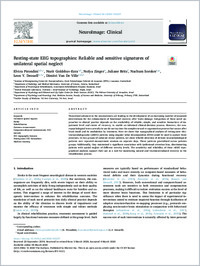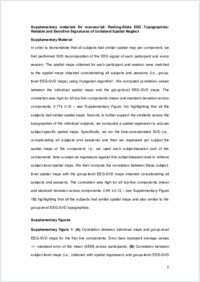Resting-state EEG topographies: Reliable and sensitive signatures of unilateral spatial neglect
- Pirondini, Elvira Institute of Bioengineering/Center for Neuroprosthetics, Ecole Polytechnique Federale de Lausanne (EPFL), Lausanne, Switzerland - Department of Radiology and Medical Informatics, University of Geneva, Geneva, Switzerland
- Goldshuv-Ezra, Nurit Department of Neurological Rehabilitation, Loewenstein Rehabilitation Hospital, Raanana, Israel - Evoked Potentials Laboratory, Technion – Israel Institute of Technology, Haifa, Israel
- Zinger, Nofya Department of Psychology and Edmond and Lily Safra Center for Brain Sciences (ELSC), The Hebrew University of Jerusalem, Israel
- Britz, Juliane Department of Psychology and Neurology Unit, Medicine Section, Faculty of Science and Medicine, University of Fribourg, Fribourg 1700, Switzerland
- Soroker, Nachum Department of Neurological Rehabilitation, Loewenstein Rehabilitation Hospital, Raanana, Israel - Sackler Faculty of Medicine, Tel Aviv University, Tel Aviv, Israel
- Deouell, Leon Y. Department of Psychology and Edmond and Lily Safra Center for Brain Sciences (ELSC), The Hebrew University of Jerusalem, Israel
- Van De Ville, Dimitri Institute of Bioengineering/Center for Neuroprosthetics, Ecole Polytechnique Federale de Lausanne (EPFL), Lausanne, Switzerland - Department of Radiology and Medical Informatics, University of Geneva, Geneva, Switzerland
-
01.01.2020
Published in:
- NeuroImage: Clinical. - 2020, vol. 26, p. 102237
Unilateral spatial neglect
Stroke
Rehabilitation
Outcome measurement
Computer-enhanced measurement
EEG analysis
EEG topography features
Resting-state EEG biomarkers
Machine learning
English
Theoretical advances in the neurosciences are leading to the development of an increasing number of proposed interventions for the enhancement of functional recovery after brain damage. Integration of these novel approaches in clinical practice depends on the availability of reliable, simple, and sensitive biomarkers of impairment level and extent of recovery, to enable an informed clinical-decision process. However, the neuropsychological tests currently in use do not tap into the complex neural re-organization process that occurs after brain insult and its modulation by treatment. Here we show that topographical analysis of resting-state electroencephalography (rsEEG) patterns using singular value decomposition (SVD) could be used to capture these processes. In two groups of subacute stroke patients, we show reliable detection of deviant neurophysiological patterns over repeated measurement sessions on separate days. These patterns generalized across patients groups. Additionally, they maintained a significant association with ipsilesional attention bias, discriminating patients with spatial neglect of different severity levels. The sensitivity and reliability of these rsEEG topographical analyses support their use as a tool for monitoring natural and treatment-induced recovery in the rehabilitation process.
- Faculty
- Faculté des lettres et des sciences humaines
- Department
- Département de Psychologie
- Language
-
- English
- Classification
- Biological sciences
- License
-
License undefined
- Identifiers
-
- RERO DOC 328539
- DOI 10.1016/j.nicl.2020.102237
- Persistent URL
- https://folia.unifr.ch/unifr/documents/308540
Other files
Statistics
Document views: 122
File downloads:
- pdf: 268
- Supplementary material: 189

